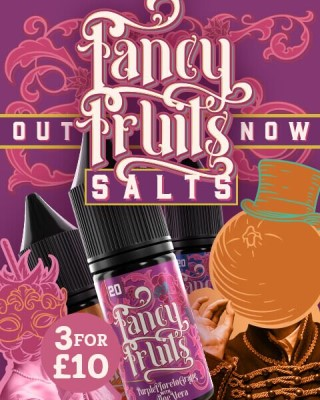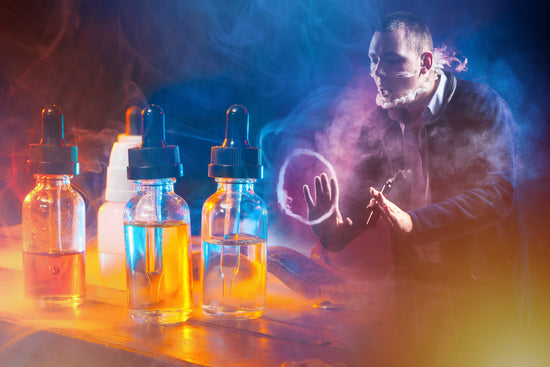Introduction
E-liquids, commonly known as vape juice or flavored e-juice, have gained widespread popularity as a key component in e-cigarettes, providing a nicotine fix without the harmful substances associated with traditional cigarette smoking.
Understanding E-Liquids
The term "e-liquid" refers to the liquid content found in electronic cigarettes (e-cigarettes) vape liquids that is heated and transformed into vapour for inhalation. Composed primarily of propylene glycol, vegetable glycerin, flavourings, and often nicotine, e-liquids serve as the fuel for your vape device. Different e liquid types offer a wide range of flavours and nicotine strengths, allowing vapers to customise their vaping experience according to their preferences and nicotine cravings.

E-Liquid vs. E-Juice: Is There a Difference?
E-liquid, vape juices and e-juice are essentially the same thing. The two terms are often used interchangeably within the vaping community to describe the liquid used in e-cigarettes. Whether it's called vape juice, vape liquid, e-juice, or e-liquid, they all serve the same purpose – to produce vapour when heated in a vape device.
What Can I Use as E-Liquid?
It's crucial to only use approved e-liquids in your vape. Using substances not intended for vaping, like water or regular juice, can damage your device and potentially pose health risks. Only e-liquids specifically designed for vapes should be used.
Is E-Liquid Stronger than Cigarettes?
The strength of e-liquid in comparison to regular cigarettes mostly comes down to the nicotine content. A standard cigarette contains about 1 gram of tobacco, which equates to around 8mg of nicotine. However, only about 1mg is absorbed during smoking. E-liquids come in various nicotine strengths, commonly ranging from 0mg to 20mg per ml in the UK. It's important to choose the right nicotine strength based on your previous smoking habits. For instance, a light smoker may prefer an e-liquid with 3mg of nicotine, while heavier smokers may opt for 12mg or 18mg.
Is it Better to Smoke or Vape?
Vaping is considered less harmful than smoking traditional cigarettes. Smoking burns tobacco, releasing harmful chemicals and carcinogens. E-cigarettes, on the other hand, heat the e-liquid to create vapour, avoiding the production of many toxic by-products. While vaping is not without risks, it's viewed as a healthier alternative and a beneficial tool in quitting smoking.
Is it OK to Drink E-Liquid?
E-liquids should never be ingested or applied to the skin. They may contain nicotine, which can be poisonous in large amounts. If you're experiencing nicotine cravings, consider nicotine replacement therapy such as vaping instead of resorting to drinking e-liquid.
Is Vape Juice Safe?
No vaping product can be considered 100% safe, but using e-cigarettes is generally seen as less risky than smoking traditional cigarettes. However, it's worth noting that the long-term health effects of e cigarettes and vaping are still being studied. It's crucial to only use high-quality, tested e-liquids and to avoid products containing harmful substances such as vitamin E acetate.

What's the Healthiest Vape?
There's no definitive answer to this as there's little research on what constitutes a "healthy" vape. However, using a vape device with a regulated and reliable e-liquid, preferably one without nicotine, would arguably be the safest option.
Can You Vape Without Liquid?
Vaping electronic cigarettes without e-liquid isn't advisable as it can damage the device. Vape devices are designed to heat e-liquid to create vapour. If there's no liquid, the device can overheat, causing potential harm.
Do All E-Liquids Work in All Vapes?
Compatibility between e-liquids and vapes varies. Certain vape devices work best with specific types of e-liquids. For example, vape pens and more advanced e-cigarettes may require different PG/VG ratios for optimal performance. Always check the manufacturer's guidelines for your vape device before purchasing e-liquids.
What Makes Cigarettes Worse Than Vaping?
Traditional cigarettes involve burning tobacco, which releases numerous harmful chemicals and carcinogens. These include tar and carbon monoxide, both linked to serious health issues such as heart disease and lung cancer. Additionally, passive smoking or secondhand smoke from cigarettes poses health risks to those around you.
On the other hand, vaping doesn't involve burning tobacco. E-liquids are heated to produce vapour, which contains fewer harmful chemicals than smoke. As such, the risk of secondhand exposure is significantly less compared to smoking. However, it's important to note that vaping isn't entirely risk-free. It's still possible to inhale harmful substances from vape products, especially those that haven't undergone stringent safety and quality testing.

Choosing the Best PG/VG Ratio for Flavour
Propylene Glycol (PG) and Vegetable Glycerin (VG) are the two main ingredients in e-liquids. PG carries flavour better, providing a stronger "throat hit" similar to traditional cigarettes. VG is thicker and sweeter, producing denser vapour clouds.
Your preferred PG/VG ratio can dramatically influence flavours and your vaping experience. For enhanced flavour and a strong throat hit, a higher PG ratio is ideal. Conversely, if large vapour clouds are your goal, choose an e-liquid with a higher VG content.
Smoking vs Vaping: A Journey to Quitting Smoking
E-cigarettes are widely regarded as a useful tool for those wanting to quit smoking. By providing a nicotine fix without the harmful effects of tobacco, e-cigarettes can help manage nicotine cravings and ease the transition away from traditional cigarettes.
In the first few weeks of quitting, e-cigarettes can be particularly helpful. Many people find the act of vaping mimics the hand-to-mouth action of smoking, making the process less challenging. Over time, vapers can gradually reduce their e-liquid nicotine strength until they're using nicotine-free e-liquid.

Wrapping Up
In conclusion, e-liquids play a pivotal role in the world of vaping. They offer a less harmful alternative to smoking, allowing for a degree of personalisation in nicotine strength and flavour. Always remember to use only high-quality, tested e-liquids and follow the guidelines for your specific vape device. While vaping is not without risks, it's a promising path for those looking to quit smoking. It's crucial to stay informed and aware of the potential health implications, and as with anything, moderation is key.
FAQs
Q: How to make vape liquid at home?
A: While it's technically possible to create your own vape liquid, it's not recommended unless you're thoroughly versed in the science behind it. Mixing propylene glycol, vegetable glycerin, nicotine, and flavours requires precision and knowledge of safe handling practices, especially when working with nicotine, which is toxic in high concentrations.
Q: Can you put water in a vape instead of juice?
A: No, water should not be used as a replacement for e-liquid. Vape devices are designed to heat e-liquid, which has a specific viscosity and boiling point. Water has a different boiling point and can damage your device, leading to poor performance or even failure.
Q: What oils are safe to vape?
A: It's essential to note that oils should not be vaped. Vaping oils can lead to lipoid pneumonia, a serious lung condition. Only vape liquids designed and tested for inhalation safety should be used in vape devices.
Q: How strong is vape liquid compared to a cigarette?
A: As we previously noted, the nicotine strength in e-liquids varies, allowing you to choose a strength that suits your needs. One cigarette contains about 1mg of absorbed nicotine, but this isn't a direct comparison due to the different methods of delivery.
Q: What are the benefits of vaping?
A: Vaping is primarily used as a cessation tool for smokers wanting to quit. It provides a similar sensory experience to smoking without many of the harmful effects. Other benefits include a wide variety of flavour choices and no secondhand smoke.
Q: Is it bad if vape juice gets in your mouth?
A: While getting a small amount of e-juice in your mouth isn't usually a problem, swallowing it can be harmful due to the nicotine content. If you frequently get e-liquid in your mouth, you may need to check if your device is functioning properly or if you're using it correctly.
Q: Are all vape juices the same?
A: No, vape juices differ in ingredients, flavour profiles, PG/VG ratios, and nicotine strengths. These factors can significantly impact your vaping experience, including the taste, throat hit, and amount of vapour produced.
Q: Can you use a vape with just water?
A: Vaping with just water is not recommended. Water has a different viscosity and boiling point than e-liquids, and vaping devices aren't designed to heat it.
Q: Why do cigarettes feel different than vaping?
A: The main difference is the delivery of nicotine. While cigarettes deliver nicotine through burning tobacco, e-cigarettes deliver nicotine through heating e-liquid. This can result in a different throat hit and overall sensory experience. Additionally, the absence of other chemicals found in cigarette smoke may also contribute to a different feeling when vaping.
Q: Is there any healthy vape?
A: While no vape product can be considered 100% safe or healthy, those that contain fewer harmful substances and lower nicotine levels are generally considered safer options. It's crucial to only use regulated vaping products and e-liquids from reputable sources.
Remember, if you're trying to quit smoking, vaping should be viewed as a tool to help you quit, not as a long-term replacement. Always consult with a healthcare provider for guidance.







